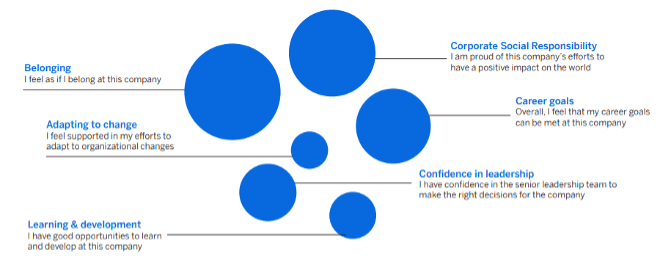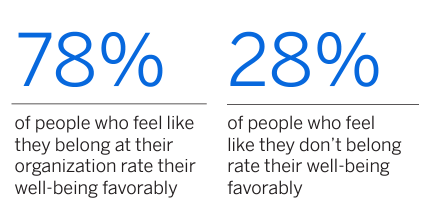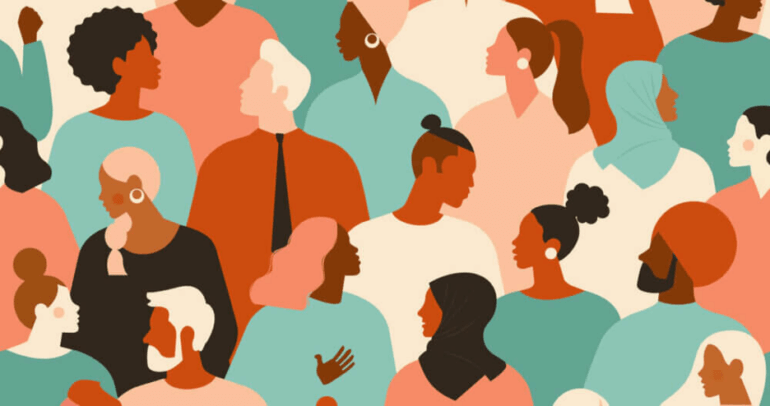We’ve all known what it feels like not to belong. Perhaps we were put on an unforgiving sports team, went to a gathering where we had nothing in common with the other guests, or attended a confrontational meeting.
We felt uncomfortable, defensive, stifled, insecure, and couldn’t wait to get out of there. Chances are, these encounters also left negative psychological marks.
After a year of organizational disruption, physical separation, global health and environmental crises, a renewed call for racial justice, and divisive political rhetoric, what people wanted most was to be a part of something bigger than themselves.
When we spoke to people as part of our global study of more than 11,800 participants at the end of 2020, a sense of belonging emerged as the strongest driver of employee engagement – ahead of typical drivers like trust in leadership and ability for career growth.
In 2023, we expect this desire for belonging to not only grow, but to completely reshape the employee experience.
Here’s a closer look at what it means to belong, what drives belonging, and how to foster a sense of belonging at your organization.
Read more: 2022 Employee Experience Trends Report
What do we mean by belonging at work?
Like food and shelter, belonging is a basic human need. It represents a connection with people or place. In a sea of uncertainty, employees feeling like they belong is the one anchor that can strengthen your organization. For many of us, our connection to our work and our colleagues has been a haven from chaos; a place – and a community – to belong to.
We all know what it feels like to belong, or to fit in with others.
When we feel we belong somewhere, we feel cared about. We can relax, breathe, express ourselves and be ourselves. We feel enough psychological safety to do things and put ideas out there, knowing we won’t be judged and rejected.
“Feeling like you can be your unique and authentic self at work and also connected to those around you fulfills our core need to form and maintain strong, stable interpersonal relationships with others."
Wouldn’t it be wonderful if we could have a feeling of belonging every day at work? Think about what could be achieved.
What is the return on investment (ROI) and business impact of belonging at work?
Belonging is highly correlated to engagement. According to our research, only 20% of employees who feel they don’t belong are engaged, versus 91% of those who feel they do – that’s three and a half times more.
A sense of belonging not only meets your employees’ basic needs, it inspires their work and drives better business results.

Belonging at work and employee engagement
Feeling that you belong at a company is a strong indicator that you’ll be an engaged employee. We know that engaged employees:
- work harder
- solve problems
- are usually willing to take on extra responsibilities
- get along well with co-workers
- grow and develop faster
When we look at the employee engagement scores for those who feel like they belong versus those who don't, it's clear how big an impact belonging has:
Conversely, unengaged employees – who may be unengaged because they don’t feel they belong - just serve their time, doing no more (and possibly less) than required.
Companies with a high level of employee engagement enjoy:
Increased performance
Research shows that a company is more likely to achieve its goals when its people are engaged in their work.
Increased revenue
Gallup finds that highly engaged teams show 23% difference in profitability, and those teams who score in the top 20% for engagement have an 81% difference in absenteeism, and 43% difference in turnover.
Better customer experience
The same Gallup study found that highly engaged workplaces deliver a 10% difference in customer ratings and an 18% increase in sales.
Higher productivity
Workplace belonging leads to a 56% increase in job performance. Workers who are supported, happy and free to be themselves are more productive.
Greater retention
Employees scoring the highest levels of belonging have a 34% higher intent to stay than those scoring low levels. And when you think the average employer spends around $4000 and 42 days hiring a new worker, retaining staff makes good business sense.
What drives belonging at work?
Business leaders
During our research, one major influence on belonging rose to the top: managers. They play a pivotal role in being the champion for their people and positively impact workplace culture.
Our research shows that managers directly influence a feeling of belonging in their teams. Employees who trust their managers, believe that they care about them as individuals, and listen to their perspectives experience a high sense of belonging. Feeling supported by inclusive leaders in adapting to organizational changes is one of the top influences on having a sense of belonging.
Read more: 2021 Employee Experience Trends Report
Diversity and diversity training
While our understanding of belonging continues to evolve, we know that it is a key component of inclusion, which has been proven many times to have great outcomes for both employees and business. These last few years have repeatedly reminded us of the importance of focusing on diversity, equity, and inclusion (DEI) in the workplace, as well as growing expectations from employees that this will be an operational imperative in the companies they want to work for.
Diversity, equity and inclusion (DEI) has, rightly, been high on progressive companies’ agendas for the last decade. It’s not enough just to pay lip service to DEI; companies must demonstrate that they’re fulfilling their DEI objectives with diversity training as standard.
But ticking the boxes isn’t enough either: sometimes companies forget that just because someone is included, it doesn’t necessarily mean they feel they belong. And belonging is a feeling – a much more formidable force than any DEI strategy handbook can offer. As Anita Sands puts it:
‘Diversity is a fact (the numbers are what they are), inclusion is a choice (you decide whether to include someone or not), but belonging is a feeling that can be enforced by a culture that you can purposefully create.’
You could have the most diverse workforce going, but when employees feel they don’t belong, you’re not hearing that invaluable and important voice of diversity that drives business success.
Only when belonging is the glue that holds DEI together, and an entire team can really appreciate each other for their unique backgrounds and feel valued, can you say you have a truly inclusive workplace.
Employee well-being
In turn, a sense of belonging has a positive effect on an important aspect of employee experience – well-being. People who feel like they belong are almost three times as likely to have a greater sense of well-being: 78% versus 28%.

Our brains use similar circuits to handle both physical and social pain and pleasure. Therefore social pains can be felt as keenly as physical injuries. When someone is excluded, isolated, or feels they don’t belong, it is, quite literally, painful. Belonging, however, stimulates the social pleasure circuits and can alleviate that pain, or not cause it in the first place.
The lack of a sense of belonging can also cause stress, depression and anxiety. These can initiate a vicious cycle of self-destructive behaviors that further prevent a person from belonging.
A strong sense of belonging is good for employee mental and physical health. Employees who feel they belong take 75% fewer sick days than those who feel excluded.
Company culture
Truly great workplace cultures have belonging at their heart. For employees to feel like they belong, employers must demonstrate they care with actions.
“This is about getting the basics right. Treating employees with respect, taking action on their feedback, and recognizing their contributions are ways to show employees that they matter. We cannot expect employees to be well, let alone thrive, in a toxic workplace.”
THIVIA MOGAN, XM SCIENTIST AT QUALTRICS
Our study also suggests that employees who live alone may garner a greater sense of belonging and community from their colleagues and friends. However, with the after effects of the pandemic and shift to remote/hybrid working, they may be more vulnerable than those with families. Ultimately, to cultivate workplace cultures, organizations must listen to employees at every stage of the employee experience and build places that make them feel they belong.
Healthy work-life balance
When work-life balance is good, employees are enthusiastic, cooperate with their team and voluntarily conform to regulations and rules. When it is poor, employees may be surly, insubordinate, discouraged, and more likely to voice their discontent with their job, company and colleagues.
Unhappy, overworked employees with no work-life balance cost a company dearly, whereas happy employees are more productive. Feeling you belong, you can be yourself, and are well supported are essential for good morale.
How to foster belonging at work
Not sure where to start with fostering a sense of belonging at your company? Factors that people say make them feel they have a sense of belonging at their organization include:
- Open and honest communication
- Feeling like a valued member of the team
- Feeling supported in adapting to organizational change
- The perception that they can be themselves at work
- The belief that their company is one where everyone can succeed to their full potential, no matter who they are
Here are some practical strategies to help create a more inclusive workplace.
Create an organizational culture of inclusion
Studies suggest that when diverse people spend time together and are treated fairly, they forge social bonds of belonging. Structure teams, problem-solving groups, remote workers and the working environment to nurture connections between co-workers. When colleagues bond, they become allies for each other.
Frequently ask yourself the question, “Am I making other employees feel they belong here?”
Inclusive approaches to consider are:
- making sure everything is accessible to all
- ensuring everyone has access to the right tech to empower them to do their best work
- using shared documents to elicit comment, rather than group meetings
- brainstorming with input from the whole team
- transparency about who makes decisions, and how.
Corporate social responsibility
Look at your organization’s corporate social responsibility (CSR) initiatives. Our research shows that employee pride in CSR – that is, the company’s efforts to have a positive impact on the world – plays a major role in fostering a sense of belonging. It is also a top driver of employee engagement just behind belonging.
Your employer value proposition
An EVP is the offering to current employees and potential job applicants that makes you a desirable employer and strengthens your employer brand. Employees who felt they belonged at work showed a 167% increase in their employer promoter score (their willingness to recommend their company to others, and an asset to an EVP).
Make employees feel welcome
Good onboarding should make a new hire feel they belong from their first day. Make day one about team introductions, a planned welcome, lunch, and a prepared team task to get stuck into immediately. Onboarding surveys tell you how well you achieved this and if you need to improve.
Share unique contributions
Storytelling is an effective communication tool for creating an environment where people feel they belong. It’s essential for hearing lost and marginalized voices. Encourage people to share personal stories, talk about who they are, what they love to do, where they’ve come from, their challenges, their experiences - and listen.
Encourage employees to bring their authentic selves to work
Image Source: Fujitsu
Increasing belonging alone is not a silver bullet solution. While it can be a powerful driver of employee engagement, this may not be a consistent experience in a diverse organization, where demographic factors can have a huge impact on experience and access to opportunities that enable employees to thrive. Integrating into a company without feeling that you can bring your authentic self to work is not inclusion, it’s assimilation.
“In the wake of a pandemic, calls for racial justice, and unprecedented change, it’s even more important for your people to feel they have the space to be their authentic selves.”
LINDSAY JOHNSON, XM SCIENTIST AT QUALTRICS
“And not only that, but what they’re a part of is having a positive impact on the world. It makes sense that these ideals are becoming integral to the employee experience.”
All organizations are different, and all the people within them have different needs. There is no one-size-fits-all solution for fostering belonging in the workplace. What’s important is to listen to what your individual people need – and then action that feedback to meet their needs.

One thing is crystal clear: employees want to feel a sense of belonging at work, and everybody must be brave to make this happen. We think that belonging and bravery go hand in hand, so much so that we’ve produced a guide to help you take the next steps in fostering belonging and bravery in your teams and organization. It has step-by-step expert advice, tips on encouraging psychological safety, and shows how to encourage belonging in a hybrid work environment.
Get all the insights from the 2022 Employee Trends Report



